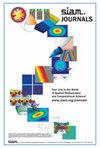Proximal Langevin Sampling with Inexact Proximal Mapping
IF 2.3
3区 数学
Q3 COMPUTER SCIENCE, ARTIFICIAL INTELLIGENCE
引用次数: 0
Abstract
SIAM Journal on Imaging Sciences, Volume 17, Issue 3, Page 1729-1760, September 2024.Abstract. In order to solve tasks like uncertainty quantification or hypothesis tests in Bayesian imaging inverse problems, we often have to draw samples from the arising posterior distribution. For the usually log-concave but high-dimensional posteriors, Markov chain Monte Carlo methods based on time discretizations of Langevin diffusion are a popular tool. If the potential defining the distribution is nonsmooth, these discretizations are usually of an implicit form leading to Langevin sampling algorithms that require the evaluation of proximal operators. For some of the potentials relevant in imaging problems this is only possible approximately using an iterative scheme. We investigate the behavior of a proximal Langevin algorithm under the presence of errors in the evaluation of proximal mappings. We generalize existing nonasymptotic and asymptotic convergence results of the exact algorithm to our inexact setting and quantify the bias between the target and the algorithm’s stationary distribution due to the errors. We show that the additional bias stays bounded for bounded errors and converges to zero for decaying errors in a strongly convex setting. We apply the inexact algorithm to sample numerically from the posterior of typical imaging inverse problems in which we can only approximate the proximal operator by an iterative scheme and validate our theoretical convergence results.
近端朗格文采样与非精确近端映射
SIAM 影像科学杂志》,第 17 卷第 3 期,第 1729-1760 页,2024 年 9 月。 摘要为了解决贝叶斯成像逆问题中的不确定性量化或假设检验等任务,我们经常需要从产生的后验分布中抽取样本。对于通常是对数凹的高维后验分布,基于朗之文扩散时间离散的马尔科夫链蒙特卡罗方法是一种常用工具。如果定义分布的势是非光滑的,这些离散通常是隐式的,从而导致需要评估近算子的朗格文采样算法。对于成像问题中的某些相关势,只能使用迭代方案进行近似计算。我们研究了近似 Langevin 算法在近似映射评估存在误差的情况下的行为。我们将精确算法的现有非渐近和渐近收敛结果推广到我们的非精确设置中,并量化了目标与算法静态分布之间因误差而产生的偏差。我们证明,在强凸设置中,对于有界误差,额外偏差保持有界;对于衰减误差,额外偏差收敛为零。我们将非精确算法应用于典型成像逆问题的后验数值采样,在这些问题中,我们只能通过迭代方案近似近端算子,并验证了我们的理论收敛结果。
本文章由计算机程序翻译,如有差异,请以英文原文为准。
求助全文
约1分钟内获得全文
求助全文
来源期刊

SIAM Journal on Imaging Sciences
COMPUTER SCIENCE, ARTIFICIAL INTELLIGENCE-COMPUTER SCIENCE, SOFTWARE ENGINEERING
CiteScore
3.80
自引率
4.80%
发文量
58
审稿时长
>12 weeks
期刊介绍:
SIAM Journal on Imaging Sciences (SIIMS) covers all areas of imaging sciences, broadly interpreted. It includes image formation, image processing, image analysis, image interpretation and understanding, imaging-related machine learning, and inverse problems in imaging; leading to applications to diverse areas in science, medicine, engineering, and other fields. The journal’s scope is meant to be broad enough to include areas now organized under the terms image processing, image analysis, computer graphics, computer vision, visual machine learning, and visualization. Formal approaches, at the level of mathematics and/or computations, as well as state-of-the-art practical results, are expected from manuscripts published in SIIMS. SIIMS is mathematically and computationally based, and offers a unique forum to highlight the commonality of methodology, models, and algorithms among diverse application areas of imaging sciences. SIIMS provides a broad authoritative source for fundamental results in imaging sciences, with a unique combination of mathematics and applications.
SIIMS covers a broad range of areas, including but not limited to image formation, image processing, image analysis, computer graphics, computer vision, visualization, image understanding, pattern analysis, machine intelligence, remote sensing, geoscience, signal processing, medical and biomedical imaging, and seismic imaging. The fundamental mathematical theories addressing imaging problems covered by SIIMS include, but are not limited to, harmonic analysis, partial differential equations, differential geometry, numerical analysis, information theory, learning, optimization, statistics, and probability. Research papers that innovate both in the fundamentals and in the applications are especially welcome. SIIMS focuses on conceptually new ideas, methods, and fundamentals as applied to all aspects of imaging sciences.
 求助内容:
求助内容: 应助结果提醒方式:
应助结果提醒方式:


